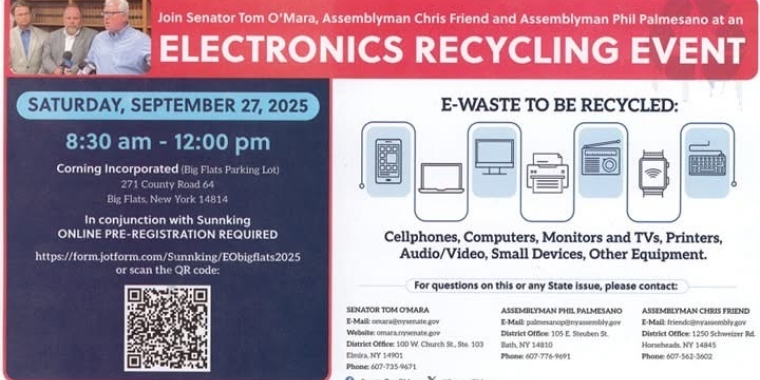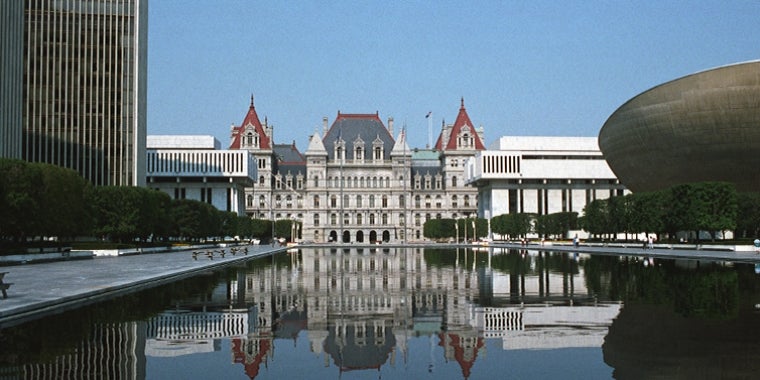
O’MARA: MAKE VOICES HEARD ON NY’s DRAFT ENERGY PLAN AND REJECT SKYROCKETING ENERGY COSTS
August 27, 2025
-
ISSUE:
- CLCPA; clean energy mandates

"It is important for all New Yorkers who have shared our concerns to continue to share them now during this public comment process to ensure that their voices are heard moving forward,” said Senator O'Mara.
Elmira, N.Y., August 27-- State Senator Tom O’Mara (R,C,I-Big Flats) is urging New Yorkers to make their voices heard during a series of public hearings beginning on September 3 and through written comments on the state’s recently released “Draft 2025 Energy Plan.”
O’Mara, however, remains critical of the upcoming public comment period for its short timeframe and for its failure to include direct public hearings in several upstate regions, including the Southern Tier and Finger Lakes.
O’Mara said, “Are we finally facing a ‘back to the drawing board’ moment on the CLCPA timeline and other climate mandates? Are we about to undertake an honest, open, long-awaited, and desperately needed public discussion on the realities of where we’re headed? Will it be followed by meaningful action out of Albany? It will be critical to provide every opportunity for public input and then to ensure that their input is taken seriously.”
The New York State Energy Board will begin a series of public hearings on Wednesday, September 3, and is accepting written public comments on the plan until early October, before finalizing an updated state energy plan.
Find out more and review the full draft plan here: https://energyplan.ny.gov/Plans/Draft-2025-Energy-Plan.
Additional information on the hearing process can be found at: https://energyplan.ny.gov/Get-Involved/Hearings.
Written comments will be accepted through October 6 and you can find out more on that process here: https://energyplan.ny.gov/Get-Involved/Comment.
O’Mara, a member of the Senate Energy and Telecommunications Committee, has said that the finalization of an updated state energy plan could mark a potentially critical turning point for this state’s energy future. The need to rethink New York’s existing energy plan has been gaining momentum for several years as doubts have steadily increased over the strategy first set in motion by then-Governor Andrew Cuomo and the Legislature’s majorities to impose radical and sweeping clean energy mandates following the enactment of the Climate Leadership and Protection Act (CLCPA) in 2019. The state’s Climate Action Council (CAC), established through the CLCPA, issued its action report in December 2022, a year and four months after Governor Hochul was sworn in as New York’s chief executive.
From the outset, O’Mara and many legislative colleagues, as well as other independent watchdogs, have warned that the failure to put forth a comprehensive cost-benefit analysis of the costs of implementing far-reaching clean energy mandates under their prescribed timelines doomed the entire effort. They have continuously questioned the affordability, feasibility, and reliability of the strategy for ratepayers and taxpayers, business and industry, and local economies.
O’Mara said, “We have raised concerns for good reasons. The newly released ‘Draft 2025 Energy Plan’ clearly acknowledges that the CLCPA timeline the state has been pushing at breakneck speed to achieve 70 percent renewable energy by 2030 and zero emissions by 2040 isn’t realistic and can’t be met under the plan with current technologies as it stands. The key bottom line here is that the ‘Draft 2025 Energy Plan’ could mark the beginning of a vital realignment, one that heeds the widespread warnings over affordability, feasibility, and reliability that have long been voiced by our Senate and Assembly minority conferences, as well as by the New York Independent Systems Operator (NYSIO), State Comptroller Thomas DiNapoli, the Empire Center for Public Policy, and other independent watchdogs. But will it? It is important for all New Yorkers who have shared our concerns to continue to share them now during this public comment process to ensure that their voices are heard moving forward.”
O’Mara, however, is already critical of the scheduled public comment period for failing to include hearings in several upstate regions and for not providing enough time for the public to provide written comments. Current hearings are scheduled to begin next Tuesday in Buffalo and continue through the end of September with additional hearings in Rochester, Albany, Poughkeepsie, Brooklyn, Bronx, and on Long Island.
O’Mara noted that while the hearings are being held in sites along the State Thruway corridor, no hearings are scheduled in the Southern Tier, Finger Lakes, Central New York, or the North Country. He has asked the Hochul administration to schedule hearings in each of these regions and to extend the current public comment period, set to end on October 6, until at least November 1.
“Too many New Yorkers in too many upstate regions, including the Southern Tier and Finger Lakes regions I represent, are not provided a readily accessible hearing site that they can attend in person. They should be afforded every opportunity to participate in one of the most important public hearings processes that this state will ever undertake, and I have asked the Hochul administration to schedule these additional hearings and to extend the public comment period until at least November 1.”
O’Mara is also raising concerns over the makeup of the state Energy Board responsible for finalizing an updated plan. The board consists entirely of the governor’s cabinet and one representative each for the Senate and Assembly majorities, as voting members. NYISO, which is responsible for managing the supply and demand of the state’s electricity, does not have a vote on the board’s decisions. The Legislature’s minority conferences are also excluded from the process.
O’Mara concluded, “The public needs to pay attention to this process and demand the appropriate accountability. Key questions are being raised. Will the state put forth a straightforward cost-benefit analysis that provides New York ratepayers with the true costs of what they’re facing if the state attempts to meet existing CLCPA targets? Bear in mind that the unknown costs of all of this will be borne by New York ratepayers, which are already taking place under the massive rate hikes being imposed by NYSEG, RG&E, and National Grid across our region. Will there be immediate, specific actions to revise, significantly delay, or eliminate current CLCPA mandates? Will public input make a difference this time around? Or is the underlying goal of the entire exercise to produce a politically expedient document? We can’t afford to have the new, final draft energy plan wind up being merely a replay of what’s taken place up to now.”
###



